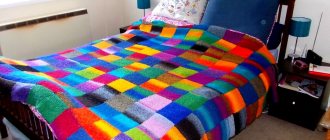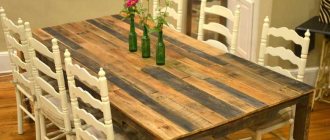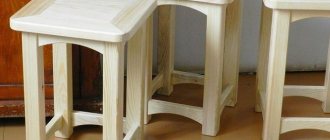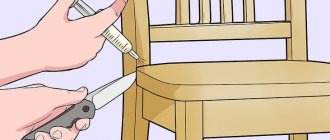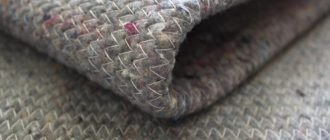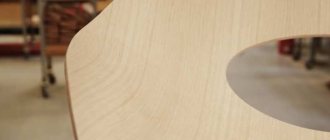Laminated or plain plywood grades 1 and 2 are widely used in the production of furniture sets. It is noteworthy that this trend is observed not only on an industrial scale. This is the material that novice craftsmen prefer for their first experience in furniture making. The optimal choice of product in this case would be a chair made of plywood - this is the easiest way to learn the basics of design, features of drawing development, and woodworking technology. And later, with more experience, it will be possible to implement more daring design ideas.
Types and features of models
Plywood is easy to work with even at home. According to its characteristics, it is a durable and relatively lightweight material. Therefore, a chair made from it is suitable for both adults and children. Such a product will look natural in the kitchen, at the dacha, or in a workshop or garage. This material is often used in the manufacture of compact camping chairs intended for fishing, picnics and other outdoor trips.
Regular and laminated plywood is often used for furniture production.
The most popular among consumers are the following models, created from plywood with your own hands or to order:
- An ordinary stool. It will look organically in the interior of any apartment or country house. Such a model consists of a small number of elements, and many parts have straight lines, which allows you to create such household items using a small number of tools;
- Folding chair. This is an indispensable thing when going outdoors. Due to its small size when assembled, it will take up minimal space in the trunk of a car or in a storage room. Although this is a more complex option compared to a stool, even beginners can still make it;
- Transformable chairs. Their difference is that they perform several functions at once, that is, they can replace several pieces of furniture. There are prefabricated or folding structures. A striking example of such models is a children's high chair that transforms into a small table and chair;
- Designer pieces of furniture. Such models usually have complex shapes, so it is better for a beginner without experience not to take on such projects. Examples of such items are a lounge chair, an armchair chair, and a plywood bar stool.
Consumables
Before making the chair, you will have to make several elements. An appropriate approach turns the event into a convenient assembly.
The main thing is that there are enough consumables:
- Plywood (two different types - for load-bearing and auxiliary elements);
- Bolts with sleeves;
- Screws;
- Wood glue;
- Accessories;
- Foam rubber for filling the soft base;
- Fabric or leather for padding;
- Antiseptic;
- Varnish.
If plywood is a mandatory consumable material, then fasteners are not found in every structure. The fact is that they can be replaced with a tongue-and-groove connection. Foam rubber and fabric can be abandoned altogether if the future user is not picky about convenience. Antiseptic and varnish will be needed if the stool is exposed to precipitation.
How to make a chair from plywood with your own hands
A do-it-yourself plywood chair will add a fresh touch to the room’s decor and will also save you money. In addition, you will gain the experience needed to create more complex furniture.
Plywood has excellent flexibility, thanks to which a skilled craftsman can give it any unusual shape.
Let's take a closer look at the manufacturing process.
Drawing up a drawing
The manufacture of any piece of furniture, be it a chair or an entire wall of furniture, begins with the creation of a drawing. You can find a suitable drawing of a plywood chair on the Internet, or draw it yourself. In this case, first of all, draw a sketch, observing proportions and dimensions. You can draw the main details separately.
Stools are traditional models that are suitable for absolutely any home or apartment.
Check the compliance of all dimensions, and especially at the connection points of the parts. Any discrepancy will lead either to a distortion of the structure or to the complete impossibility of assembly. Consider the location of the necessary parts on a sheet of plywood; this step will reduce the amount of material required.
All structural elements are smooth and straight - few of them are required, so the chair can be assembled with minimal use of tools.
Material selection
When choosing and purchasing materials, follow several rules:
- For the main parts of the frame, plywood sheets with a thickness of at least 18 mm are used, and for the seat and back, sheets with a thickness of 12-16 mm are used. The specified thickness is suitable for models intended for adults. For children's furniture, the thickness can be reduced by 1-3 mm;
- chair height should be 42-48 cm for adults, 25-35 cm for children;
- outdoor furniture requires moisture-resistant plywood;
- beautiful appearance of furniture is obtained only when using plywood of the first or second grade.
Plywood is considered the best material for beginning furniture makers, since it does not require special knowledge in the field of design or processing skills.
Drawing up a drawing
It is advisable to begin work precisely from this stage, since when trying to make furniture directly by eye, adjusting the dimensions in the process, the result most often does not live up to expectations. Any discrepancy in size, incorrect placement of grooves, holes will inevitably lead to distortions or complete inability to assemble the chair. In general, project development comes down to the following steps:
- Drawing a sketch in compliance with proportions and dimensions.
- An image of the main parts from which the structure will be assembled, in the form of a diagram.
- Refining the appearance of each of them, checking the conformity of sizes, especially at the connecting points.
- Development of a detailed drawing on graph paper. At this stage, it is necessary to consider the relative position of the elements in accordance with the dimensions of the existing sheet of plywood. This will help reduce material consumption.
- Based on the resulting drawing, templates are cut out, with the help of which the outline of the individual elements is transferred to the working material.
It is worth noting that all this work can be done using free programs designed for drawing. After this, you can print the drawings in the desired format.
It is much easier to solve the design problem by searching for detailed diagrams for plywood chairs on thematic resources. This will significantly reduce time, because drawing drawings with your own hands, even on a computer, is a rather labor-intensive task.
Manufacturing stages
After purchasing the materials, you can begin work. To do this, use paper templates to transfer the image of the parts from the drawing to the plywood. Cut out the necessary elements.
For self-production, ordinary stools or folding chairs are most often chosen.
When working with plywood, it is better to use a circular saw or jigsaw, which will make the edges smoother. The edges of the resulting parts must be sanded or sanded. Use colored impregnations to paint the elements.
A hand-made plywood chair, if decorated beautifully, can be a wonderful gift for a loved one.
Simple stool
This is the easiest option. To make it, you need 3 identical plywood plates that will act as legs, and a separate piece of plywood for the seat. The legs will be connected to each other using grooves that need to be cut out on them. Next, use self-tapping screws and a mounting part to attach the seat. The edge of the seat can be covered with special tape.
Folding chair
To make a folding chair, you will need to cut 3 parts from plywood: the first serves as the front support and backrest, the second as the back support, and the third as the seat. After this, mark with a pencil the places for fastening the hinges and drill the holes.
Important! If you screw screws without holes directly into plywood, it may delaminate.
Connect the parts using loops and the plywood folding chair is ready.
The folding design is compact and convenient; it does not require much material.
Tools
Although the chair looks simple, making it can be challenging. If some masters have to fill their hands, others need to replenish their inventory with the following tools:
- Drill;
- Measuring tools (square, ruler, level);
- Mallet;
- Furniture conductor;
- Hammer;
- Clamps;
- Vise;
- Grinder machine;
- Screwdriver;
- Electric jigsaw.
The furniture jig, which is an assembly of cap corners, deserves special attention. The latter can be adjusted for precise sawing as well as drilling holes.
A furniture jig and an electric jigsaw can be replaced with a manual wood milling machine. But the presence of all the listed tools is only welcome, because... The manufacture of a chair involves operations of varying complexity. They must be performed on a workbench in a well-lit place.
High chair
A children's high chair is a much more complex product. To connect parts together, it is better to use confirmats instead of conventional self-tapping screws, which will provide additional reliability. Cut out the necessary parts from plywood and drill holes for fasteners, accurately observing the dimensions. Sand the edges and surfaces of the parts themselves. Assemble the product.
Particular attention must be paid to sanding the edge parts remaining from the jigsaw.
Important! When tightening the confirmations, do not tighten them too much.
Paint is rarely used, mainly for children's furniture. Products for adults are coated with wear-resistant varnish as standard.
Decoration methods
If you plan to place the chair outdoors or take it into nature, you need to choose a suitable material for painting. Alkyd or acrylic paints are an excellent option. They are resistant to moisture and are considered one of the most durable. In addition, they do not emit an unpleasant pungent odor. Acrylic is able to protect wood from all kinds of damage and the negative effects of water. When painting, the surface is initially sanded, cleaned, and only then the composition is applied. For this purpose, several brushes differing in size are used.
If there are defects on the surface of the chair, they are eliminated using putty. After this treatment, paint is applied to the product. In this case, it is better not to use varnish, otherwise traces of putty will be noticeable, and accordingly, the structure will not have a very attractive appearance.
Thanks to beautiful decor, furniture becomes unique and unusual. For finishing it is worth using upholstery fabric. To make the back and seats soft, you will also need additional foam rubber. It is laid out on the structural parts and the facing fabric is pulled on top. For this purpose, it is allowed to use any dense material - its edges are tightened and fixed with a stapler.
Furniture decorated using the decoupage technique also looks original. In this case, they take old wallpaper and glue it to the slats in the area of the back and seat, after which the product is varnished. Bright designs with vegetation look very attractive. The work is completed by painting the supports and legs; for this purpose, paint is used that best matches the shade of the decor.
The simplest way to decorate created furniture is to apply a pattern. In this case, moisture-resistant paints are used. A chair decorated with carvings also looks excellent, although such decoration will require more time and effort.
Anyone can make a folding chair. The process of its manufacture is very simple and, in fact, does not cause any difficulties. To do this, you just need to choose the appropriate model and stock up on the necessary materials. In just a few hours you can create excellent, comfortable furniture that can be used in every home.
Varnishing
Painting
Fabric upholstery
Decoupage
Small fishing chair
A chair for fishing or for picnics is the simplest product with which it is recommended for a person without experience to start making homemade furniture. It is necessary to cut two supports in accordance with the diagram. Connect them together using the existing grooves. Attach strong fabric to the top edges of the supports.
The chair is ready, and due to the special shape of the grooves it will fold, so when delivered to the river bank it will not take up much space.
What to consider when choosing a design
A stool is a versatile piece of furniture that can be hidden in a closet or garage if desired. But in order for the finished product to be truly functional, the choice of design must be approached competently . Factors such as the shape and size of the stool, as well as the type of upholstery, must be taken into account.
Stools with different upholstery
Form
When choosing a stool design, you need to pay attention to the shape of the finished product - it should match the shape of the table. For example, if the table is rectangular, then round stools will not go well with it. Furniture items should complement each other.
Homemade folding stools
Upholstery type
Due to the fact that the plywood stool will be used intensively, it is advisable to select types of materials for upholstery that do not require special care. Such materials include eco-leather, flock and other washable options. Of course, the color of the upholstery should be combined with the interior of the room.
The upholstery should be durable and low maintenance
Chair dimensions
Another important criterion that you need to pay attention to when choosing a stool design. To make the products convenient to store and use, their height and width should allow stools to be placed under the table. This rule does not apply to bar stools, because they should initially be high.
DIY stool ladder
What else can a chair be made from?
In addition to plywood, wood, metal or plastic can be used to make chairs. Each of these materials has its own pros and cons. For example, wood is easy to work with, but it is massive and prone to rot. Metal is durable, but its use is impossible without special tools. Plastic is a lightweight and durable material, but is not resistant to mechanical stress.
A homemade chair is the most suitable item to try your hand at making furniture with your own hands. But the time and effort spent will be rewarded in the end with a practical and beautiful product.
Collapsible stool
The main difference between a stool and a chair is the absence of a backrest. Therefore, the stool is light in weight and easily slides under the table. And if there are no screws among the consumables, then they can be replaced with grooves.
This will not degrade the stability of the structure:
- First, first-grade plywood must be cut into three identical triangles with a length of at least 100 cm (the length of the triangle is three lengths in total);
- Next, a second sheet of plywood is used, which will serve as a blank for sawing the seat in the form of a hexagonal triangle;
- The next stage is the creation of oblique cuts for each load-bearing triangle (in one segment, the two lower cuts are directed in different directions, in the second, the side cuts are directed downward, in the third, the side and bottom cuts are directed downward and upward, respectively);
- Next, the triangular elements are cut into the slices (therefore, the thickness of the slices should correspond to the thickness of the segments);
- A seat is placed on top of the assembled supporting base.
You can use screws to secure the seat. But they need to be screwed into the back of the stool through a small piece of plywood.
